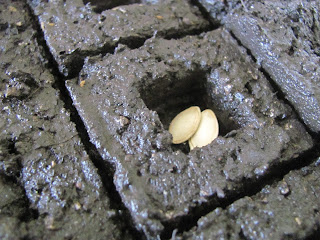I love fall gardening. Summer gardening is the type of gardening that
bursts at the seams, and there is a constant flurry of activity to keep up with all of
the picking, weeding, and preserving that comes with it. It is demanding and hot, the weeds come up faster than you can pick them, and there is no shortage of bugs ready to chow down on all of your hard work. And while I love our summer garden bursting with gorgeous produce, I also love when the days cool down, the hard labor is done, and gardening takes on a
slower, more relaxed pace.
There’s also something pretty darn satisfying about plucking
carrots out of the ground on Thanksgiving day and picking hardy winter greens,
like kale, when the ground is covered in a blanket of snow!
Carrots can be a pain to start in July so they're ready in the fall, but it's worth it! They can stay in the ground even when it's cold outside and can be harvested throughout the winter as needed, which comes in handy if you don't have a root cellar!
These turnip greens are known as run-up turnips in the south and they are the bomb! The greens can be harvested throughout the fall and winter, but the amazing thing is that you can overwinter them and they will produce one last picking of sweet, tender greens in early spring.
Nothing is worse than when a hard frost destroys our greens, and I go to the store to purchase them and am stopped dead in my tracks every time I see their outrageous price tag. Luckily not only is kale a superfood in the health world, but it's a superstar in the garden too... When everything else is dead and frozen, this stuff can take the hard frosts and snow, and due to the cold temps converting its starches to sugar, the bitter flavor mellows out too!
There are a few different cold hardy lettuces, like this red oak leaf lettuce. It holds up pretty well when the night temps dip down but the days warm up. You want to pick it mid-day when the frost has melted off of it, otherwise it makes for a soggy salad. Once our daily temp stays hunkered around freezing, it won't be good any more, so we're eating it up now!
Beets are a beautiful root vegetable for the fall garden that add an earthy flavor to fall dishes.
One of my favorite things to grow are beans. I could get on a soapbox proclaiming all the virtues of dry beans, but I'll save that for another post! I start dry beans in July and harvest them in the fall. Dry beans are the staple of several winter dishes at our dinner table, they store well, and anything we don't eat (or decide to save) can be planted the next summer.
We tuck in our fall plants at night under coverings to protect them from hard frosts.
Sometimes we forget and they get covered in ice.
Whoops!
A gentle spray of water helps to melt the ice.
This kale looks as good as new!
Happy gardening!

















































